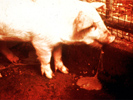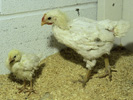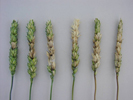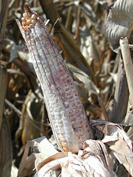David G. Schmale III
Virginia Polytechnic Institute and State University, Blacksburg, VA
Gary P. Munkvold
Iowa State University, Ames, IA
TRICHOTHECENES
 |
|
Figure 12/P> |
 |
|
Figure 13 |
 |
|
Figure 14 |
 |
|
Figure 15 |
The trichothecenes are the largest group of mycotoxins known to date, consisting of more than 150 chemically-related toxic compounds. These mycotoxins are produced by several species of Fusarium, Stachybotrys, Trichoderma, and Trichothecium. The most important trichothecene mycotoxin in the United States is deoxynivalenol (DON), a common contaminant of wheat, barley, and maize. DON is sometimes called vomitoxin because of its deleterious effects on the digestive system of monogastric animals [Figure 12]. Humans consuming flour made from wheat contaminated with DON often demonstrate symptoms of nausea, fever, headaches, and vomiting. In Europe, another trichothecene mycotoxin known as T-2 toxin may contaminate small grains. T-2 toxin has been implicated as part of the alleged chemical warfare agent 'yellow rain' in Southeast Asia. T-2 toxin causes a fatal disease of humans known as alimentary toxic aleukia (ATA); a disease that was particularly problematic in Russia in the 1940s. Symptoms of ATA in humans include skin pain, vomiting, diarrhea, complete degeneration of bone marrow, and eventually death. Broiler chickens fed low doses of T-2 toxin may demonstrate symptoms of weight loss, feather malformation, and yellowing of the beak and legs [Figure 13].
Trichothecene contamination is economically important in wheat, barley, oats, and maize. Fusarium graminearum (sexual stage Gibberella zeae) is the leading cause of DON contamination in maize and small grains in the United States. The fungus causes a disease of wheat and barley known as Fusarium head blight [Figure 14] and a disease of maize known as Gibberella ear rot [Figure 15]. Infected wheat spikelets exhibit premature bleaching as the pathogen progresses within the head and the developing grain becomes contaminated with DON. Maize ears infested with F. graminearum are often covered with a pinkish fungal mycelium as the maturing kernels become contaminated with DON. Click here for a plant disease lesson on Fusarium head blight.
Next: Zearalenone
